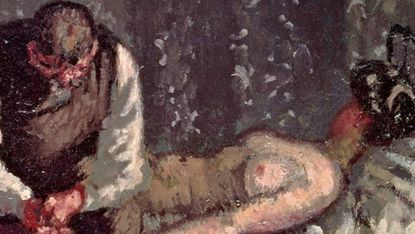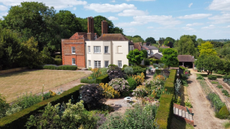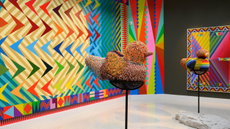Walter Sickert at Tate Britain: a ‘riveting’ retrospective of work by ‘the duke of darkness’
‘Superbly curated’ exhibition underlines fact that Sickert was a very ‘uneven’ painter

There’s a fantastically sinister series of self-portraits at the start of Tate Britain’s “riveting” new Walter Sickert exhibition, said Laura Cumming in The Observer. Sickert (1860-1942) paints himself glowering in the shadows, “one eye homing in on you like a target”; hovering menacingly behind a bust of a bare-knuckle boxer; apparently barring the way between a nude model and the exit. This was how Sickert wished to be seen: as “a disrupter, an actor, a menace, a taunt”. His art is theatrical, “ostentatious, even sensational”.
At the same time, influenced by Degas and Bonnard, he was determined to record contemporary urban life – a subject he considered as worthy as any biblical episode or mythological set piece. His work conjures up a “dank land of rented rooms, sickly streets and gaslit pubs”. This “superbly curated” exhibition – the first major retrospective of his work in London for three decades – allows us to see the whole of his career. It takes in everything from his architectural paintings of northern French towns to his nudes – infamous in their day – to his extraordinary paintings based on photos from the 1930s. There’s a “haunting” portrait, for instance, of Edward VIII just before his abdication.
Sickert was “the duke of darkness”, said Alastair Smart in The Daily Telegraph. In his hands, the most wholesome of scenes were rendered shadowy; even his paintings of architectural landmarks, such as a view of the Église Saint-Jacques in Dieppe, seem to have been painted at sundown. And his “devastating” Camden Town Murder series was inspired by the real-life murder of a prostitute in the “then-insalubrious” London district, to which he had just moved.
Subscribe to The Week
Escape your echo chamber. Get the facts behind the news, plus analysis from multiple perspectives.

Sign up for The Week's Free Newsletters
From our morning news briefing to a weekly Good News Newsletter, get the best of The Week delivered directly to your inbox.
From our morning news briefing to a weekly Good News Newsletter, get the best of The Week delivered directly to your inbox.
In one work, L’Affaire de Camden Town, he paints a fully clothed man staring down “menacingly” at a naked woman on an iron-frame bed. The interior is “cramped” and “dimly lit”, the brushwork “vigorous”; you get the uneasy sense that the scene is about to burst into violence. These are the paintings that have led some “crackpots” to believe that Sickert was Jack the Ripper. “Tough viewing” though they are, the Camden paintings are standouts in a “frustrating” show that is simply too big for its own good. Containing some 150 works, it is a “trudge”. Nor does it really explain the great paradox of Sickert: how “a purveyor of stark documentary realism” was at the same time so melodramatic and theatrical.
The exhibition underlines the fact that Sickert was a very “uneven” painter, said Jackie Wullschläger in the FT. Nevertheless, he was rarely boring – and at his best, he could really dazzle. Little Dot Hetherington at the Bedford Music Hall, one of many paintings of London theatres here, “fizzes with the nervous energy of performance”. In three views of Venice’s St Mark’s Cathedral (1895-96), he paints “like a jeweller”, capturing the building’s “crosses, spires and mosaics tinged pink or emerald or gold according to time of day”. His greatest painting is 1915’s Brighton Pierrots, a depiction of a wartime seafront performance that “bursts into ecstatic, unreal chromatic harmony”.
In the past, critics have complained that Sickert wasn’t single-minded enough. Today, we’re more forgiving: born in Munich, brought up in London, he connects Britain and Europe, modernism and English realism. “Hybrid, uncertain, painting loose and free”, he is “our contemporary”.
Create an account with the same email registered to your subscription to unlock access.
Sign up for Today's Best Articles in your inbox
A free daily email with the biggest news stories of the day – and the best features from TheWeek.com
-
 5 high-caliber cartoons about Kristi Noem shooting her puppy
5 high-caliber cartoons about Kristi Noem shooting her puppyCartoons Artists take on the rainbow bridge, a farm upstate, and more
By The Week US Published
-
 The Week Unwrapped: Why is the world running low on blood?
The Week Unwrapped: Why is the world running low on blood?Podcast Scientists believe universal donor blood is within reach – plus, the row over an immersive D-Day simulation, and an Ozempic faux pas
By The Week Staff Published
-
 Rishi Sunak's asylum spat with Ireland explained
Rishi Sunak's asylum spat with Ireland explainedIn Depth Irish government plans to override court ruling that the UK is unsafe for asylum seekers
By The Week UK Published
-
 Properties of the week: houses with enchanting gardens
Properties of the week: houses with enchanting gardensThe Week Recommends Featuring pretty homes in Hampshire, Devon and West Sussex
By The Week UK Published
-
 Venice Biennale 2024: from the good to the bad to the downright 'bizarre'
Venice Biennale 2024: from the good to the bad to the downright 'bizarre'The Week Recommends Central exhibition features the work of some 330 artists
By The Week UK Published
-
 Sunset Song: gripping theatre that's 'close to magic'
Sunset Song: gripping theatre that's 'close to magic'The Week Recommends Morna Young's 'first-class adaptation' of Lewis Grassic Gibbon's classic novel
By The Week UK Published
-
 Challengers: 'the most purely pleasurable film of the year so far'
Challengers: 'the most purely pleasurable film of the year so far'The Week Recommends Zendaya plays a former tennis player turned coach in this 'almost ridiculously' sexy drama
By The Week UK Published
-
 Baby Reindeer: a 'compelling and unforgettable' series
Baby Reindeer: a 'compelling and unforgettable' seriesThe Week Recommends Comedian Richard Gadd's disturbing Netflix drama about stalking
By The Week UK Published
-
 Daniel Wallace's 5 favorite books that should not be forgotten
Daniel Wallace's 5 favorite books that should not be forgottenFeature The author recommends works by Italo Calvino, Evan S. Connell, and more
By The Week US Published
-
 6 picturesque homes in Arizona
6 picturesque homes in ArizonaFeature Featuring a glass elevator in Sedona and a grotto waterfall in Paradise Valley
By The Week Staff Published
-
 Silversea cruise review: a Central and North American adventure
Silversea cruise review: a Central and North American adventureThe Week Recommends An incredible journey featuring cultural exploration, cooking classes, comfort and more
By Yasemen Kaner-White Published